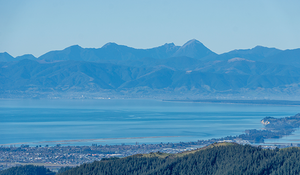
Photo Credit: itravelNZ® - CC-BY 2.0
At the top of the South Island [Te Waipounamu] lie two bays, divided by a small headland. The western bay is known to local Māori as Mohua and the eastern bay as Te Tai-o-Aorere.
In 1642, Dutch explorer Abel Tasman labelled the wider bay Moordenaars’ Baij [Murderers’ Bay] after four of his men were killed there.
When Cook first sailed past in 1770, he thought the two bays were simply one and labelled it 'Blind Bay', believing it to be Tasman's Murderers' Bay. On his next voyage in 1773, he refers to only the eastern bay as 'Blind Bay'.
In 1827, Dumont D’Urville, a French explorer, entered the headlands and confirmed that there were two bays within: he labelled the western one ‘Massacre’ and the eastern one ‘Tasman’, stating that he followed Cook in that naming. He labelled the head that divided the bays Point de Séparation (now officially ‘Separation Point / Te Matau’).
Massacre Bay and Blind Bay were used for a while; John Lort Stokes used them on his comprehensive surveys of New Zealand, as he used charts made from Cook’s information.
In 1842, coal was discovered in the western bay and for a time it was called ‘Coal Bay’. Then gold was discovered as Collingwood and the much more appealing ‘Golden Bay’ was used. Studies of contemporary newspapers have shown that ‘Massacre Bay’ was used more often in the 1850s and 1860s, while ‘Golden Bay’ starts to be used in the 1860s.
Maps frequently included both or either names. By the time the Honorary Geographic Board of New Zealand was established in 1924, Golden Bay had gained prominence.
The eastern bay was referred to as either ‘Blind Bay’, ‘Tasman Bay’ or ‘Blind or Tasman Bay’ for many years, but after World War Two, Tasman Bay appears to have been more popular.
In 2014, the names Tasman Bay / Te Tai-o-Aorere and Golden Bay / Mohua were made official by two acts under the settlements of Ngāti Kōata, Ngāti Rārua, Ngāti Tama ki Te Tau Ihu, and Te Ātiawa o Te Waka-a-Māui, and Ngāti Apa ki te Rā Tō, Ngāti Kuia, and Rangitāne o Wairau.
References
- NZ Gazetteer, Tasman Bay / Te Tai-o-Aorere
- NZ Gazetteer, Golden Bay / Mohua
- ‘The first meeting - Abel Tasman and Māori in Golden Bay’, The Prow
- James Cook, ‘31 March 1770’, South Seas: Voyaging and Cross-Cultural Encounters in the Pacific (1760-1800)
- James Cook, in JC Beaglehole (ed), The journals of Captain James Cook on his voyages of discovery, Vol. 2, Hakluyt Society, Cambridge (England), p. 142
- S. Percy Smith, ‘Captain Dumont D'Urville's Exploration of Tasman Bay in 1827’, Transactions and Proceedings of the Royal Society of New Zealand, Vol. 40, 1907, p. 416
- 'GOLDEN BAY', from An Encyclopaedia of New Zealand, edited by A. H. McLintock, originally published in 1966. Te Ara - the Encyclopedia of New Zealand